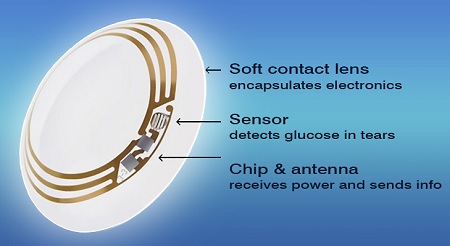One of the first major moves from Google’s healthcare team will create an always-on patient monitoring service for diabetics, unlocking new types of communication channels for brands and pharmaceutical marketers.

Earlier this year, Google unveiled a ‘smart contact lens’ that that monitors glucose levels in tears, designed to help diabetics avoid having to prick their fingers to draw blood as much as 10 times a day.
Now, Swiss pharmaceutical company Novartis is turning them into a commercial reality.
The two companies have announced that Novartis is licensing Google’s technology to create special contact lenses for diabetic patients.
The contact lens has been developed by Google at its secretive X lab during the past 18 months. It looks like a normal contact lens, but inside is a tiny glucose sensor and wireless transmitter.
Sandwiched in the lens are two glitter-specks loaded with tens of thousands of miniaturised transistors, while the lens is ringed with a hair-thin antenna. Vision is not obscured because the embedded electronics are outside the eye’s pupil and iris.
The new lenses will analyse tear fluid in the eye and provide real-time, constant measurement of an individual’s glucose levels. That data will then be transmitted wirelessly to a mobile, enabling users to monitor their condition easily.
“The internet of things will revolutionise patient healthcare, unlocking new ways for brands to communicate with their patients. The approaches will drive greater compliance with medication, and create accurate “big data” about behaviours that will be invaluable in unlocking new types of treatment programmes”, explains Danny Meadows-Klue, author of the Digital pharmaceutical marketing academy. “This deal between google and Swiss pharmaceutical company Novartis is turning that sci-fi vision into a commercial reality”.
A solution for 400 million diabetics?
There are around 400 million diabetics worldwide that currently have to monitor their blood sugar and tweak their insulin dose to keep their levels under control, or face potentially dangerous complications. The new device aims to avoid this uncomfortable and inconvenient procedure.
Shrinking the parts to such a small size was a major task, according to Brian Otis, one of the lead researchers.
“We’re testing prototypes that can generate a reading once per second,” Otis said. “We’re also investigating the potential for this to serve as an early warning for the wearer, so we’re exploring integrating tiny LED lights that could light up to indicate that glucose levels have crossed above or below certain thresholds.”
Research began several years ago at the University of Washington, and other medical devices are being designed elsewhere.
